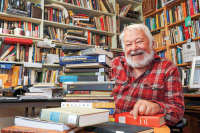Double the fun
 I had the pleasure of participating in two Christmas Bird Counts (CBCs) this past weekend. The first was the Balsam CBC on Friday Jan. 2. This was our 13th count — 12th official — and we had 18 participants. Our unofficial tally for this year’s count was a little on the low side: we recorded 68 species and I believe average is (or was, before this year) 73.
I had the pleasure of participating in two Christmas Bird Counts (CBCs) this past weekend. The first was the Balsam CBC on Friday Jan. 2. This was our 13th count — 12th official — and we had 18 participants. Our unofficial tally for this year’s count was a little on the low side: we recorded 68 species and I believe average is (or was, before this year) 73.
Birders, subjectively, don’t make the best scientists — they’re all about the rarest, prettiest, most species. The scientist is about documenting as accurately as possible what is being observed. The Audubon CBC; the granddaddy of citizen-science (this year marks the 115th annual Audubon CBC) tries to ameliorate, to some extent, these birder tendencies by having group leaders record mileage (driven and/or walked,) hours spent in the field, weather conditions, species seen and number of species seen.
Citizen science is sloppy science, for sure, but it is valuable science. According to a National Audubon Society press release: “Citizen science programs, most notably Audubon’s Christmas Bird Count and the Breeding Bird Survey, are foundational to conservation policy in the United States. Fights over conservation dollars in Congress and statehouses, land management decisions, and wildlife policy are all influenced by information collected through the CBC and other citizen science programs.
“We’ve led the way, from the Endangered Species Act listing and eventual recovery of the bald eagle to winning protections for vulnerable waterfowl, including the American black duck. CBC data form a cornerstone of the analyses contained in federal “State of the Birds” reports, a concept pioneered by Audubon.
“And today, as birds face unprecedented threats from climate change and energy development, the CBC is more relevant than ever, including the EPA’s use of our data as one of its key climate change indicators.”
But it’s the “citizen” — not the “science” — aspect of the CBC that got the ball rolling back 115 years ago and still sustains it. The camaraderie of being afield with like-minded souls probably rousts more CBC participants out of bed on those cold and/or wet winter mornings than any thoughts of scientific contribution. And when darkness begins to envelope count day and participants gather to share lists and swap stories of the ones that did or didn’t get away, it’ll be that camaraderie that takes center stage. And it’s that camaraderie that’s integral to conservation.
Related Items
But don’t forget sexy! And there’s always a shot for something out of the ordinary. This year’s Balsam CBC turned up a female scarlet tanager. And if the record is accepted it will be the first official record of a winter scarlet tanager in the mountains of North Carolina. There are only four records and they are from the coast and/or piedmont. Climate change?
I believe this was the fourth annual Franklin CBC. And it was a soggy one. Something about having other idiots — I mean other dedicated birding friends with you that can make even a drenching a pleasurable experience. Thanks Brent, Angela-Faye, Jack, Hugh, Janice, David and Kim! The unofficial total for the Franklin count was 63 — a little above their average.
I have to say my favorite bird from the Franklin count was the red-headed woodpecker. We counted four together along the Franklin Greenway near the Macon County Library — probably part of a resident colony. Can’t wait to go back this spring and see if they are still there. Red-headed woodpeckers always transport me back to Mer Rouge, Louisiana, where I grew up. There was hardly a yard or vacant lot around town that didn’t have at least one huge water oak in it and it was common to see and hear red-headed woodpeckers everywhere.
(Don Hendershot is a naturalist and a writer. He can be reached at This email address is being protected from spambots. You need JavaScript enabled to view it..)









